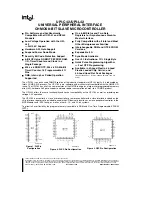
UPI-C42/UPI-L42
Table 1. Pin Description
DIP
PLCC
QFP
Symbol
Pin
Pin
Pin
Type
Name and Function
No.
No.
No.
TEST 0,
1
2
18
I
TEST INPUTS:
Input pins which can be directly tested using conditional
branch instructions.
TEST 1
39
43
16
FREQUENCY REFERENCE:
TEST 1 (T
1
) functions as the event timer
input (under software control). TEST 0 (T
0
) is a multi-function pin used
during PROM programming and ROM/EPROM verification, during Sync
Mode to reset the instruction state to S1 and synchronize the internal clock
to PH1.
XTAL 1
2
3
19
O
OUTPUT:
Output from the oscillator amplifier.
XTAL 2
3
4
20
I
INPUT:
Input to the oscillator amplifier and internal clock generator
circuits.
RESET
4
5
22
I
RESET:
Input used to reset status flip-flops, set the program counter to
zero, and force the UPI-C42 from the suspend power down mode.
RESET is also used during EPROM programming and verification.
SS
5
6
23
I
SINGLE STEP:
Single step input used in conjunction with the SYNC output
to step the program through each instruction (EPROM). This should be tied
to
a
5V when not used. This pin is also used to put the device in Sync
Mode by applying 12.5V to it.
CS
6
7
24
I
CHIP SELECT:
Chip select input used to select one UPI microcomputer
out of several connected to a common data bus.
EA
7
8
25
I
EXTERNAL ACCESS:
External access input which allows emulation,
testing and ROM/EPROM verification. This pin should be tied low if
unused.
RD
8
9
26
I
READ:
I/O read input which enables the master CPU to read data and
status words from the OUTPUT DATA BUS BUFFER or status register.
A
0
9
10
27
I
COMMAND/DATA SELECT:
Address Input used by the master processor
to indicate whether byte transfer is data (A
0
e
0, F1 is reset) or command
(A
0
e
1, F1 is set). A
0
e
0 during program and verify operations.
WR
10
11
28
I
WRITE:
I/O write input which enables the master CPU to write data and
command words to the UPI INPUT DATA BUS BUFFER.
SYNC
11
13
29
O
OUTPUT CLOCK:
Output signal which occurs once per UPI instruction
cycle. SYNC can be used as a strobe for external circuitry; it is also used to
synchronize single step operation.
D
0
– D
7
(BUS)
12 – 19
14 – 21
30 – 37
I/O
DATA BUS:
Three-state, bidirectional DATA BUS BUFFER lines used to
interface the UPI microcomputer to an 8-bit master system data bus.
P
10
– P
17
27 – 34
30 – 33
2 – 10
I/O
PORT 1:
8-bit, PORT 1 quasi-bidirectional I/O lines. P
10
– P
17
access the
signature row and security bit.
35 – 38
2



































